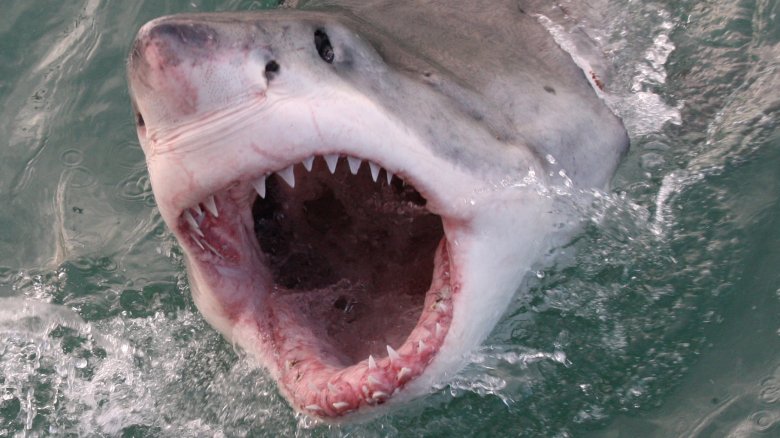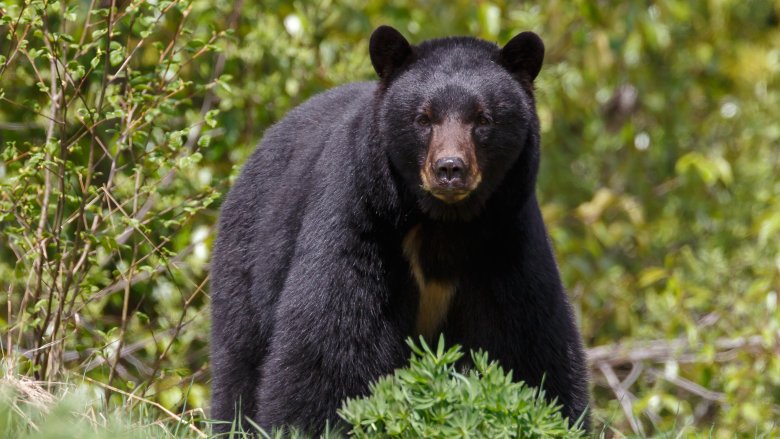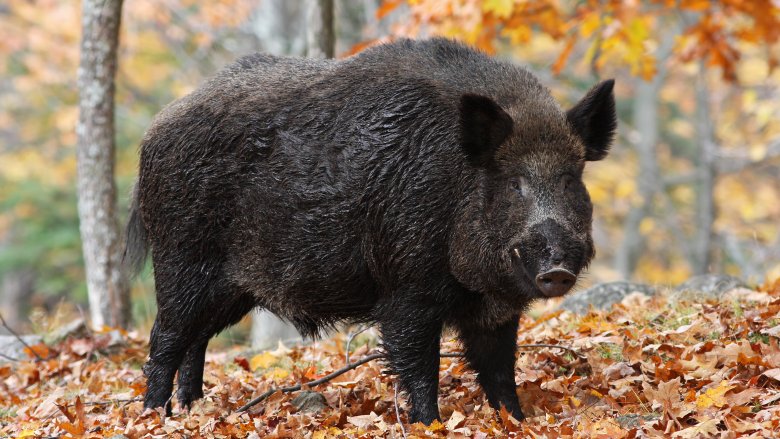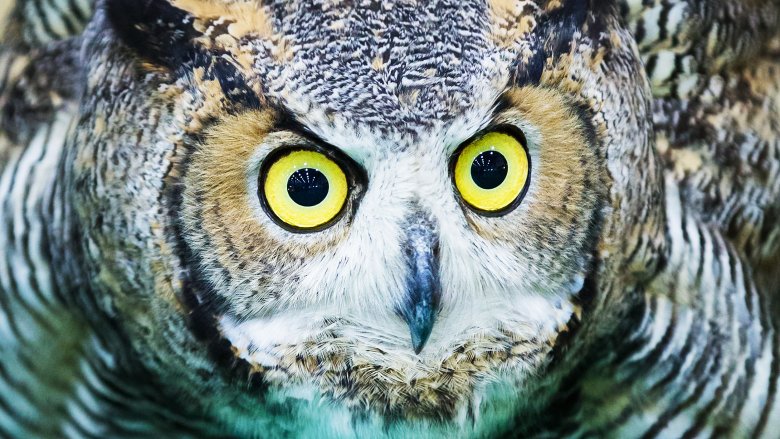Real Towns Terrorized By Nightmare Creatures
Like most people, you've probably dreamed of having a special slice of earth to call your own. Ideally, that slice would be situated in a town of cozy climes and friendly faces. It would feel just like Moe's Tavern, but without the crippling alcoholism and jaundiced skin. For some that happy hope may even become reality. Dreams do come true, after all. Unfortunately, so do nightmares. Some towns are fraught with feral terrors that eclipse the sun. Others resound with the preternatural shrieking of monsters that lurk outside your door. These places are plagued by nature's boogeymen, and you're about to meet them.
The Jaws of lifeless
The 1975 thriller Jaws cast the beach as a place where flailing bodies got steeped in their own blood by a great white shark. Like many iconic movie villains, the shark would later jump itself in a silly sequel -– namely, the one where a deranged great white stalked a single family. However, while Jaws' antagonist lost its serrated edge, its real-life counterpart remains a bone-chilling tribute to seaside murder.
The true story of Jaws began on the coast of Beach Haven, New Jersey, in 1916. At the time the notion of someone dying by a shark's hands (fins?) seemed preposterous. As the BBC noted, scientists deemed sharks too weak-jawed to pierce human bone. And according to the History Channel, they had a reputation as timid creatures that wouldn't dare accost someone. That perception evaporated as a 70-mile stretch of New Jersey beach towns became an aquatic feeding trough.
Between July 1 and July 12, four star-crossed swimmers got chomped to death. Local mayors downplayed the incidents, and a Philadelphia newspaper ran the unhelpful headline "Bathers Need Have No Fear of Sharks." But as fatalities mounted, panic washed over the public. Alarmed New Jerseyans mobilized to catch the killer. The putative culprit –- a 9-foot great white shark –- ultimately met its match when it attacked a boat and was bludgeoned to death with a broken oar. The dramatic tale inspired books, movies, and Sam Jackson getting hilariously snapped in half by CGI sharks.
Dead unburied
Bears: the world's cuddliest killers. You see them as oversized stuffed animals. They see you as delicious stomach stuffing. It's a match made in heaven, at least insofar as bears will send you there. However, not every ursine beast wants to commit adorable violence against you. Some feel right at home munching on cemetery corpses like zoological zombies. Residents of Vezhnya Tchova, Russia have witnessed it firsthand.
Located near the Arctic Circle, Vezhnya Tchova became a hangout for hungry black bears in 2010. As The Guardian explained, blazing summer heat plus a shortage of mushrooms, frogs, and berries drove the bears out of the wild and into the wild world of necrophagia. Unsatisfied with eating trash and mauling people (which they also did), the furry foragers entered graveyards and devoured the dead. According to local media, a pair of villagers encountered one of these tombstone raiders after confusing it with an old man crouched over a grave. Like horror film characters they approached, only to find a bear getting grisly with casket meat. While fleeing, the villagers saw corpse clothes strewn about. Hopefully they also saw a therapist.
Disturbingly, the bears could have easily coped without their cemetery snack bar. Animal welfare expert Masha Vorontsova cited fish and ants as readily available food sources. The predators just wanted an easy meal with an earthy flavor. Bears that choose to be grave robbers (grave rob-bears?) might be the scariest thing in the history of ever.
The other fright meat
Nuclear plant meltdowns have a dystopian air about them -– probably due to ambient radiation. They're salient reminders that with great atomic power comes great powerlessness when things go terribly awry. The 2011 Fukushima meltdown, for instance, left a trail of tainted milk, spinach, and drinking water, not to mention the humans directly exposed to radiation. Perhaps most freakishly, it also created toxic boars.
Nobody expected a poisonous pork posse. But as the New York Times explained, wild boars flourished after the Fukushima accident, despite extreme exposure to radiation. Government officials found that some of the animals contained 300 times more cesium than is legally safe. But instead of becoming heaps of inedible pork chops, the boars went berserk and started ravaging towns like Tomioka. Having lost all decorum, the porcine pests ran roughshod over farmland and barged into people's homes. They also attacked people.
Those who left their houses during the meltdown had another reason to stay gone while current residents had a compelling impetus to leave. To provide citizens some relief, local leaders brought in hunters. As per The Independent, the hired guns would lure boars with rice and then blast them into oblivion. Hunters slaughtered 800 of them in Tomioka alone. Then again, if the animals can withstand fatal amounts of radiation, maybe they can also survive death. Just to be safe, the hunters should probably turn the boars into bacon and lock them in a lead refrigerator.
Scarred and feathered
Imagine seeing scores of people out on a clear night nervously brandishing umbrellas and wearing helmets. You'd probably assume you stumbled across a wacky performance art exhibit or a collection of crazy people. Perhaps, but it's entirely possible those cuckoos just dread the vicious bird flying overhead. In fact, a Dutch town experienced that exact ordeal back in 2015.
As per the Washington Post, the people of Purmerend did well to shield their heads at night. Otherwise they exposed themselves to the unforgiving talons of a gargantuan eagle owl. Found in Europe and Eurasia, the beast boasts a wingspan of 6 feet and the power to move human bowels with a single swoop. What attracted the avian juggernaut to Purmerend is unclear, but its random attacks on pedestrians showed it clearly meant business.
The eagle owl's status as a protected species prevented people from deep-frying their assailant and gorging on vengeance. By contrast, the owl targeted the some of the town's most vulnerable folk: the elderly and disabled. So it was basically a serial bully. The New York Daily News reported that the bird victimized about 50 people before its eventual capture. To prevent a procession of bloody heads and pitchforks, the local government grudgingly brought in a falconer to fetch the owl. Officials planned to relocate the bird to a "suitable place," which –- given its lust for brutality –- hopefully means prison.
Beetle mania
When Americans recall the 1964 Beatles Invasion, they revisit a time when all you needed were love and copious amounts of drugs. When the villagers of Saint-Maurice-Montcouronne, France, recall their 2014 beetle invasion, they long for a yesterday when their troubles seemed so far away and didn't haunt their sleep. They might also crave narcotics, but only to dull the memory of getting harassed by insect hordes on a nightly basis.
According to The Local, the multi-limbed madness began when a farmer ceased tending to the soil. Soon thereafter, emboldened beetles swarmed the land in droves, entering households by the thousands. Sleep became the prelude to waking nightmares as residents would rise to an inexorable expanse of insects. As one villager explained, "It's disgusting and exhausting, when there are thousands in your home. You crush tens of them just getting out of bed." Once crunched, the beetles release a foul odor as if to add insult to severe psychological injury.
Incredibly, the villagers not only resisted the urge to hack off their beetle-stained feet, but also maintained the wherewithal to contact government officials for help. However, rather than recommending a fleet of exterminators, a representative from France's office for insects and their environment dismissed the bug frenzy as a mere inconvenience. The village mayor had even grimmer news. After consulting specialists, he had warned residents that the beetle sieges would only get worse with time. Translation: no one in Saint-Maurice-Montcouronne should ever leave their bed again.
Bold yeller
It probably won't surprise you that the people of Kozhikode, India, have a long and storied history with dogs. Basically all of humanity does. But while most societies would liken that connection to the film Air Bud, life in Kozhikode feels more like a deleted scene from Cujo. Only, instead of getting hunted by an unbathed Saint Bernard, these residents get hounded by crazed canine armies.
As per Newsweek in September 2016, aggressive, often rabies-addled strays swarm the city at sundown, sealing off sidewalks and stalking pedestrians. A single pack can have as many as 50 dogs. Bites, chases, and fiercely fanged faces await those who leave their homes after dark. But even those who stay indoors only enjoy a token solace. Skulking canines park themselves at people's doors as if holding them hostage. They topple trash cans and scrap for food, unleashing what one resident described as "bloodcurdling screams." Presumably, those screams are unfailingly accompanied by tremulous human sobs.
Fearful citizens fit their walls with barbed wire, broken glass, and nails just to keep the fearsome dogs at bay. Some have taken to pelting the animals with rocks to dissuade them from attacking. Feral dogs have become such a menace that in Kozhikode and similarly affected cities, the government rounds up and sterilizes the strays. Unfortunately, where there's a willy, there's a way to reproduce. So even while cities see improvement, dogs continue popping out terror puppies. On the positive side, Kozhikode's pooper scooper merchants must be millionaires now.
Maul of the wild
As the saying goes, leopards can't change their spots, making them easy to spot in urban settings. A disadvantage like that should make the beasts hesitant to hunt in man's land. But for one ferocious feline, the concrete jungle proved little more than a fleshy ball of yarn.
In 2016, CNN recounted the chaos caused when a 6-year old leopard ran loose in Bangalore, India. Security at the Vibgyor International School first noticed the feline a little after 4 a.m. on a Sunday. Like a furry phantom in would disappear for hours at a time, only to resurface on camera. By 3:30 p.m. the leopard had tired of mind games and simply entered the school like it owned the place. Quick-thinking officials trapped it in a bathroom. Unfortunately, the cat was quicker.
Like a cinematic escape artist, the leopard exited through a ventilation duct and resurfaced by the school's swimming pool. Startled bystanders made a run for it, and the cat made sport of them. The leopard lacerated multiple people, even pulling one man to the ground as he tried to scale a fence. Thankfully, a tranquilizer dart subdued the animal, but even that took nearly two hours to work. Afterward, officials took the leopard to kitty jail. But as CNN unsettlingly reported, the captive cat mysteriously escaped. It may one day return for revenge, but perhaps the greatest retaliation is to leave residents nervously pondering its whereabouts.
Fur and loathing
Given the wide assortment of poisonously stab-tastic animals living in Australia, it should take virtual hellspawn to faze an Aussie. So you'd imagine a flying fox invasion elicits little more than a half-shrug over there. After all, wasn't Sonic the Hedgehog's sidekick a flying fox? That thing's scrumptiously cute, but it's the wrong kind of fox. See, in Batemans Bay, Australia, the flying foxes are actually giant bats. And instead of sporting sweet rotary tails, they have 3-foot wingspans and caustic excrement.
According to The Telegraph, in April 2016, giant bats outnumbered people in Batemans Bay by a 12-to-1 ratio. These roughly 140,000 flying foxes suffocated the town with an ungodly stench and defiled human ears with screams of the damned. The constant sensory torment drove local Danielle Smith to the point of depression. Smith lamented in an interview: "I can't open my window at all because the smell is so bad. We can actually taste it — that's how strong it is."
In addition to traumatizing ears and noses, the bats damage cars with their acidic poop. Adding to their pestilential aura, the nuisances knock out electricity on occasion. In April 2016 alone, thousands of bats plowed into power lines over the course of nine straight nights. Finally fed up, the town obtained permission to purge the pests by deadly means if necessary. Perhaps the townsfolk will petition to change the town's name to Patrick Bateman's Bay because they've obviously gone bat-crap crazy.
Scream weaver
You probably wouldn't view floods as a source of arachnophobia unless a flood is specifically made of spiders. As it turns out, your hypothetical assessment is both accurate and horrifyingly prescient. According to National Geographic, rising waters send spiders scrambling for higher ground, but even in this vulnerable state, they insist on torturing mortal eyeballs. In a bid for survival, the antsy arachnids coat any dry surface they can with webs, making disaster-stricken areas look like giant Halloween displays.
In 2012, for example, the city of Wagga Wagga, Australia, got drenched in floodwaters before drowning in an ocean of spider-filled webs. Entomologist Robert Matthews described it as a "striking phenomenon" before presumably punching himself in the eye out of revulsion. Villagers in rural Argentina had a much less flattering description for their arachnid insurgents in 2015. As per The Independent, residents in flood-ravaged areas were treated to an all-consuming wave of thick, pulsating spider webs, which they called "baba del diablo," or "slime of the devil."
Even pristine New Zealand fell victim to the post-flood disaster. In 2017, Global News reported that a 98-foot-wide web engulfed a soccer field. A woman and her stepson approached the writhing mass believing that insects had fallen prey to it. Instead they found thousands of spiders, some of which ascended the stepson's legs. Obviously, kindness is weakness in the arachnid world, a lesson those Kiwis won't soon forget.
Burdens of a feather
Turkeys have a reputation for being delicious. That's probably why on the fourth Thursday of every November, Americans gobble up an estimated 46 million of them. While most families consume these birds with gluttonous glee (and cranberry sauce), the townsfolk of Teaneck, New Jersey, likely eat them with bitter malice in their hearts.
That's because in 2016, wild turkeys haunted Teaneck like ghosts of Thanksgiving future. As NBC explained, the foul birds charged at pedestrians and tried to force their way into homes. One of those tasty terrors burst through the kitchen window of Courtney Lopchinsky as she sat with her children. During an interview Lopchinsky described an explosion of glass shards and frenzied flapping. As the bird frantically waved its wings, glass sprayed everywhere. According to NJ.com, the intrusion caused $6,000 worth of damage. Lopchinsky suffered cuts and contusions and even had auditory flashbacks.
Teaneck's not the only locale suffering from post-turkey stress disorder. In nearby Hillsdale, a mailman had to dial 911 when malevolent turkeys prevented him from leaving his truck. Frustratingly, residents can't do much about these avian assaults. Wild turkeys are protected by law, meaning they get a free pass to act like jerks. The closest residents can come to retaliation is spraying turkeys with hoses or running them off. Perhaps someone should try basting the turkeys to see if it wigs them out.
Sea know evil
People usually think of seaweed as a mostly flavorless sushi ingredient. Beyond that, it doesn't get a half-second's notice. And why should it? At best it's exotic lettuce, and at worst it's green paper masquerading as lettuce. Or at least that's what seaweed wants you to think. Visit the beaches of Brittany, France, and you'll see this sea garnish in a sinister new light.
In 2009, the BBC published a startling report about seaweed overtaking parts of the French coastline. Initially innocuous, the plant packs a toxic punch after death. The decomposing seaweed hardens and potent hydrogen sulfide gas accumulates underneath. Any man or animal that nears this organic landmine risks a swift and noxious demise. Beachgoer Vincent Petit learned this the hard way while riding his horse along the beach. His trusty steed made the mistake of trusting the air and got a lungful of hydrogen sulfide as reward. Minutes later the horse was an inert mass sprawled across the sand.
Government officials have sought to stem the toxic tide for decades. But every year the pernicious plant returns, imperiling tourists and townsfolk alike. Even worse, humans might have started this predicament. Wired blamed the seaweed problem on manure dumped by farmers. Polluting poop jacks up nitrate concentrations in the water, which catalyzes seaweed growth and turns the beach into a literal wasteland. It's like a hokey sci-fi film about human folly, only instead of creating French Godzilla, Brittany got really bad gas.






